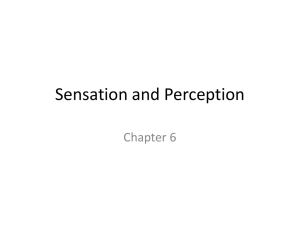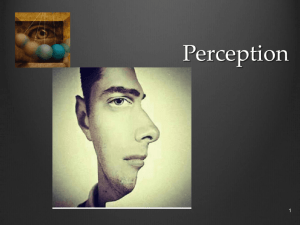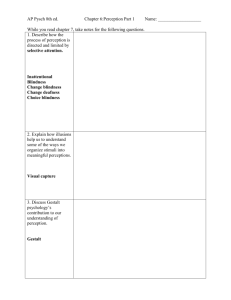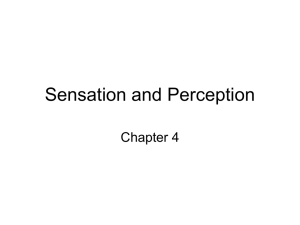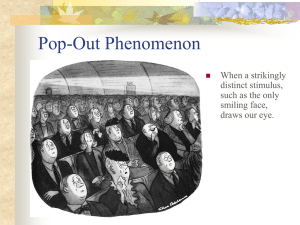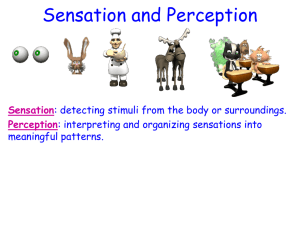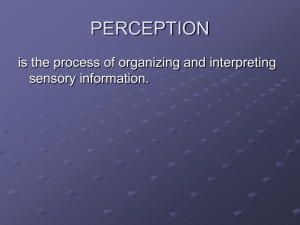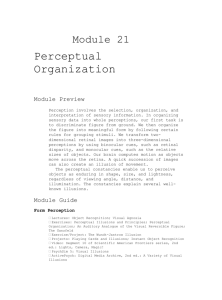Motion Perception
advertisement
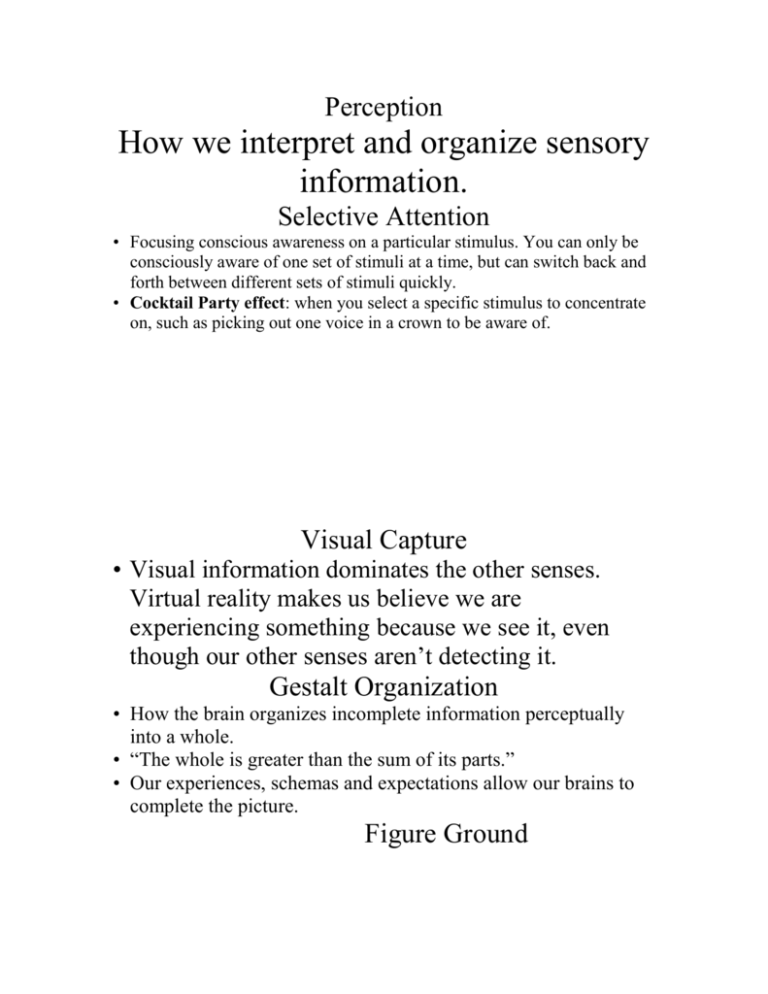
Perception How we interpret and organize sensory information. Selective Attention • Focusing conscious awareness on a particular stimulus. You can only be consciously aware of one set of stimuli at a time, but can switch back and forth between different sets of stimuli quickly. • Cocktail Party effect: when you select a specific stimulus to concentrate on, such as picking out one voice in a crown to be aware of. Visual Capture • Visual information dominates the other senses. Virtual reality makes us believe we are experiencing something because we see it, even though our other senses aren’t detecting it. Gestalt Organization • How the brain organizes incomplete information perceptually into a whole. • “The whole is greater than the sum of its parts.” • Our experiences, schemas and expectations allow our brains to complete the picture. Figure Ground The first step in organizing the environment is the ability to pick out objects from the background. Your brain uses its feature detectors to look for curves, lines, angles and movements to give it clues. Gestalt groupings tendencies • Proximity: we group nearby figures together as a part of the same group. • Similarity: we group similar objects together. • Continuity: perceive smooth continuous patterns rather than broken up ones. Gestalt groupings tendencies • Closure: filling in the space to create a complete whole: constellations. • Connectedness: perceive spots, lines or areas as connected when uniform and linked. Depth Perception • Ability to see objects in three dimensions and judge distances even though the images that hits the retina(s) are two dimensional. The following slide uses shading to make two dimensions appear three. Binocular Cues • Retinal disparity: each retina sees a slightly different version of the object and judges it’s dimensions. • Convergence: a neural muscular cue based on the convergence of the eyes which helps the brain judge distance by how the eye has to work to focus on a scene or object. Monocular Cues: one eye’s enough • Interposition: if one object blocks part of another, we assume it is closer. • Relative Clarity: the further away an object is the less distinct the image. So on foggy days, objects appear further than they are. • Relative Size: if we assume two objects are of similar size, and image on retina differs, we assume the smaller is further away • In the next slide, who’s taller, the boy furthest away or the boy holding hands with the boy with the baseball hat? • Now look at the figure of the boy in the white shirt at the bottom of the slide? Monocular Cues: one eye’s enough • Texture Gradient: a gradual change from a grainy look to a finer, smaller look indicates a change in distance. • Relative Height: We perceive objects higher in our visual field to be further away. (although this is reversed when the object is above the horizon.) Painters use this technique to show distance. Monocular Cues: one eye’s enough • Relative motion: As we move, stationary objects appear to move past us unless we fix on them, then we feel like we’re moving. If we fix on an object, objects in front of our fixation point move backward and the closer they are, the faster they move. Objects behind the fixation point move with us and at a decreasing speed with distance. (You need to try this to get it) Monocular cues cont. • Linear Perspective: Parallel lines moving away from us seem to converge, like with railroad tracks. (Don’t mix this up with the binocular cue, convergence.) • Relative Brightness: Nearby objects reflect more light to us, therefore appear brighter to the retina than distant objects. This can also make objects appear further in the haze. Motion Perception • Stroboscopic Movement: a rapidly series of slightly moving objects is perceived as moving. Like moving pictures. • Phi Phenomenon: when two lights next to each other move back and forth, we perceive them as being the same light passing back and forth. Like with movie marquees that look like a moving row. Perceptual Constancies • Perceptual constancies allow us to perceive an object as unchanging even the stimuli changes. Shape and Size Constancy • Shape: for instance when a door opens, we still see it as a door in motion rather than several different objects. • Size: we see things as the same size even with the retinal image changed, we see it as distance change. Size Relationships • Some say that because we are raised in a carpentered world with lots of right angles, we adjust our perception to match the corners of rooms. Two identical lines appear different in length if you attach an arrow to one as it would appear if it were closer and to the other as if it were further. See the next slide. • This theory is further supported by the fact that those who do not live in carpentered worlds, do not have the same perception. So there. Size Distance relationships. • Familiar objects that change size on our retinas are perceived as farther away or closer, rather than changing in size. • A baseball hitter can instantly determine speed, trajectory and calculate where the ball will be in 4/10th of a second. The brain makes that calculation by understanding that familiar objects getting larger in our visual field are getting closer and at what rate, not larger.. Lightness Constancy • White paper reflects 90% of the light on it, black paper 10%. • Outdoors, black paper may reflect 100 times the amount of light as white paper does indoor, yet we still see it as black. • That is lightness constancy, which is caused by relative luminance, or the amount of luminance that surrounds the object. Our brain adjusts. Sensory Restriction and Restored Vision • Critical Period: there seems to be a critical period for the development of neural connections for the senses. If restricted during this period, complete perception does not occur, even when the sensory apparatus is restored. Sensory Adaptation When sensory information is distorted or changed, upper mammals (humans) adapt and can function appropriately. Even when flipping the world upside down using special lenses, humans can adapt and function after just a few weeks. Perceptual Set • Remember: the brain is constantly trying to organize the world. Once it sees a stimulus in a certain way, it is more difficult to see if differently, it locks in. This is called perceptual set. Remember from problem solving? Breaking set is seeing the problem in a different way. Schemas organize our perceptual sets. Context Effect • The brain uses context clues to interpret sensory information. Experiences, expectations and assumptions color our perception. This explains why those raised in violent or fearful environments may respond differently than those who aren’t. What seems to be a benign look to you or me, may be a threat to them. Extra Sensory Perception • • • • • Never any laboratory proof. Telepathy: mind to mind communication. Clairvoyance: perceiving remote events Precognition: predicting the future. Psychokinesis: moving objects with your mind. Human Factor Psychology • Human factor psychologist use the human’s natural perceptual tendencies to design appliances, machines and work places to be safer and more efficient.

